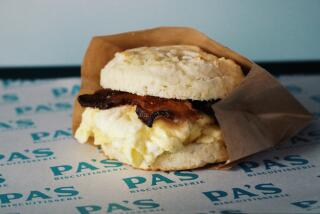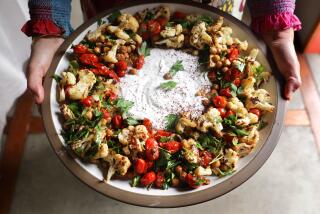Summer Herbs : Fresh Herbs: The Magic Sprig
- Share via
Fresh herbs are available in supermarket produce sections throughout the year. They present the bright essence of an herb’s flavor in a way that the dried form can’t begin to do. The drawbacks of fresh herbs are that they are highly perishable--and very expensive when you get them from the supermarket.
Fortunately, you can easily grow your own, guaranteeing a fresh and inexpensive supply. Plant a variety of fresh herbs in pots, then use them in your summer cooking--in soups, salads, vegetable dishes, marinades, sauces.
Consider starting your summer herb adventures with the following recipes, all jointly developed by Chicago restaurateur Rick Bayless and Susan Goss, chef at Bayless’s Restaurant Zinfandel. They highlight the special essence of flavor that fresh herbs bring to a dish.
Bayless’ quick tips:
* Add fresh herbs during the cooking, then add a little more when the dish is about finished, to introduce the fresh flavor of the uncooked herb.
* For an explosion of flavor, garnish a dish with chopped or julienned fresh herbs just before serving.
*
I urge you to make your own strawberry vinegar; it will be a boon to your summer cooking. It’s easy to make and is full of bright, deep flavor without being harsh. You could use it as a salad dressing all by itself, with only a touch of oil. In this recipe, reserve the remaining dressing for a fresh fruit salad or perhaps a salad of small spinach leaves with quartered strawberries and marinated sweet onions.
SUMMER HERB SALAD WITH STRAWBERRY VINAIGRETTE
About 6 cups loosely packed mixed baby lettuces
About 2 cups loosely packed assorted summer broadleaf herbs such as basil, scented geranium, nasturtiums, borage, arugula, mint, summer savory, flat leaf parsley
Strawberry Vinaigrette
Rinse lettuces and herbs. Carefully dry in salad spinner or between paper towels. Wrap in paper towels and refrigerate until time to serve, up to 6 hours.
Put lettuces and herbs in large salad bowl. Stir Strawberry Vinaigrette, then measure 1/2 cup. Sprinkle over salad and gently toss to coat. Makes 4 to 6 servings.
Each of 4 servings, including Strawberry Vinaigrette, contains about:
535 calories; 599 mg sodium; trace cholesterol; 56 grams fat; 13 grams carbohydrates; 3 grams protein; 0.83 gram fiber.
Strawberry Vinaigrette
1/2 cup strawberry vinegar
1 cup corn, canola or safflower oil
1/3 cup halved ripe strawberries
1 tablespoon plus 1 teaspoon clover honey
1 scant teaspoon salt
1/4 teaspoon freshly ground black pepper
*
Combine vinegar, oil, strawberries, honey, salt and pepper in blender and puree until smooth. Dressing should have consistency of loose mayonnaise. Adjust seasonings to taste. Dressing should be tangy. Can be made ahead, stored in covered, non-reactive container in refrigerator. Let come to room temperature before using. Makes 1 1/2 cups dressing.
Each 1-tablespoon serving contains about:
85 calories; 98 mg sodium; trace cholesterol; 9 grams fat; 1 gram carbohydrates; trace protein; 0.01 gram fiber.
Note : If strawberry vinegar is unavailable, substitute mild white wine vinegar. Then increase strawberries to 1/2 cup when making the dressing. Or make strawberry vinegar by putting 1 quart of very ripe (even blemished) strawberries in non-reactive container and cover with mild white wine vinegar. After 1 week or so, strain, bottle and store in dark, cool place.
*
This almost cake-like tart is great for picnics--it transports easily and is delicious at room temperature. Basically, you can use any seasonal vegetables; asparagus, shiitake and sweet onions went into the mixture I tried. Bayless suggests using baby artichokes, trimmed and quartered, in the vegetable mix (if you can find them). This tart is a carry-out item at Zinfandel’s food market.
ZINFANDEL’S ROASTED VEGETABLE TART WITH FRESH HERBS
Biscuit Crust Dough
4 cups asparagus, cut into 2-inch pieces
2 loosely packed sliced Shiitake mushrooms
1 cups sliced sweet onions
1 1/2 tablespoons olive oil
1/2 cup sliced (oil-packed) sun-dried tomatoes, julienned
1 1/4 teaspoons salt
1/4 teaspoon freshly ground black pepper
1/2 cup loosely packed chopped mixed herbs
2 large eggs
1 1/2 cups nonfat plain yogurt
1 scant teaspoon poppy seeds
1/2 teaspoon paprika
*
Grease 9 1/2-inch springform pan. Transfer Biscuit Crust Dough to pan and press with hands to cover bottom of pan. Refrigerate Biscuit Crust while cooking vegetables.
Combine asparagus, mushrooms and onions in bowl. Spread mixture on large foil-lined baking sheet. Sprinkle with olive oil and toss to coat evenly. Cover vegetables with sheet of foil and bake at 425 degrees 15 minutes. Remove foil cover, stir vegetables well and bake, uncovered, stirring occasionally, until asparagus is tender and onions begin to brown, about 30 minutes longer. There should be no liquid in pan, and vegetables should not be mushy.
Transfer vegetables to mixing bowl. Stir in sun-dried tomatoes, salt, pepper and herbs. Evenly distribute vegetables over biscuit crust.
In small mixing bowl, lightly beat eggs, then stir in yogurt. Spoon yogurt mixture over vegetables and spread evenly. Sprinkle surface with poppy seeds and paprika.
Bake at 425 degrees until top is set and brown, 30 minutes. Let stand 10 minutes before slicing. Tart may be served warm from oven or at room temperature. Makes 6 to 8 servings.
Each serving contains about:
446 calories; 973 mg sodium; 104 mg cholesterol; 19 grams fat; 58 grams carbohydrates; 19 grams protein; 4.82 grams fiber.
Biscuit Crust Dough
1 3/4 cups flour
1 1/4 teaspoons baking powder
1/2 teaspoon salt
6 tablespoons very cold unsalted butter, cut into 1/2-inch cubes
3/4 cup buttermilk
Combine flour, baking powder and salt in bowl of food processor fitted with metal blade. Pulse several times to mix well. Add butter and pulse until mixture looks like cornmeal. Add buttermilk and pulse until dough just begins to clump together. Do not over-process. Dough will be sticky.
Turn dough clumps out onto heavily floured work surface. Lightly flour top. Gather clumps together and gently knead 3 to 4 times (no more).
*
The basil-lemon dressing goes extremely well with both the slaw and the smoked salmon. This quantity is for appetizer or first-course servings. If you want to serve the salad as a light meal, you may want to increase the amount of slaw. Reserve any unused dressing for another batch of slaw, or other salads such as potato salad with arugula.
SMOKED SALMON WITH BASIL-LEMON SLAW
1 3/4 cups thinly sliced napa cabbage
1/2 cup thinly sliced radicchio
3/4 cup finely julienned fennel bulb
12 basil leaves, 6 finely julienned and 6 left whole for garnish
Basil-Lemon Slaw Dressing
1 pound unsliced smoked salmon, cut into 6 equal serving portions
1 1/2 tablespoons maple syrup
1/2 teaspoon coarsely ground black pepper
1/3 cup salmon caviar, optional
Combine cabbage, radicchio, fennel and sliced basil in large bowl. Can be chilled several hours, covered airtight.
Stir Basil-Lemon Slaw Dressing. Add 1/2 cup to slaw. Toss well. Add additional dressing if necessary.
Arrange salmon pieces on baking sheet. Brush with maple syrup and sprinkle with pepper. Bake at 425 degrees until heated through and just beginning to firm, about 5 minutes.
Divide slaw among 6 chilled salad plates. Top with piece of warm salmon, garnished with scant tablespoon of salmon caviar and basil leaf. Serve immediately. Makes 6 servings.
Each serving contains about:
605 calories; 1,906 mg sodium; 53 mg cholesterol; 60 grams fat; 7 grams carbohydrates; 15 grams protein; 0.16 gram fiber.
Basil-Lemon Slaw Dressing
1 large egg
Zest 1 large lemon, roughly chopped
1/3 cup fresh lemon juice
1 1/2 cups oil
1 tablespoon white wine vinegar
1 1/2 tablespoons roughly chopped basil leaves
1 teaspoon salt
1/2 teaspoon freshly ground black pepper
*
Put egg, zest and juice in blender. Mix until zest is finely chopped. With blender running, slowly pour oil in steady stream. Mixture will resemble soft mayonnaise. Add vinegar, basil, salt and pepper and blend until thoroughly combined. Adjust seasonings to taste. Dressing should be tangy and well seasoned. Cover and refrigerate, if not using right away.
Note : Although many recipes call for uncooked eggs, the U.S. Department of Agriculture has found them to be a potential carrier of food-borne illness and recommends that diners avoid eating raw eggs. Commercial egg substitutes may be used in place of raw eggs in certain circumstances. Check egg substitute package for applications.
More to Read
Eat your way across L.A.
Get our weekly Tasting Notes newsletter for reviews, news and more.
You may occasionally receive promotional content from the Los Angeles Times.










